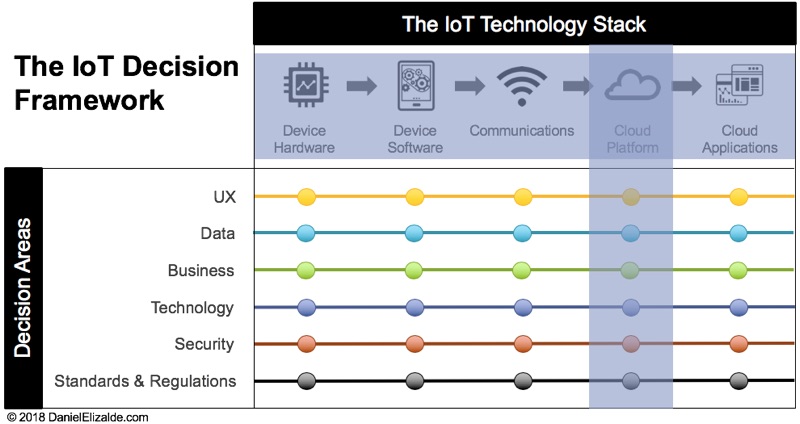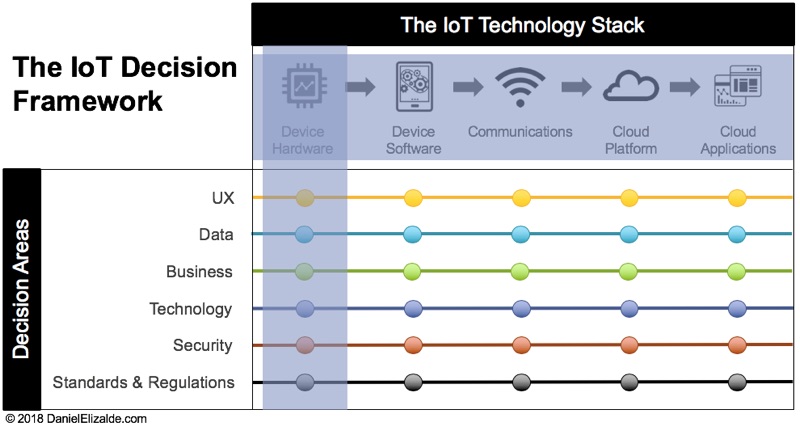
As the Internet of Things continues to grow, more and more companies are leveraging this technology and business trend to grow their business and impact their bottom line.
Despite the vast opportunities the Internet of Things provides, many companies are struggling to build IoT products and manage all of their corresponding complications. There is one thing these companies are missing: the people with the right skills to manage the complexities of IoT products throughout their lifecycle.
Although this challenge might sound familiar to many Product Managers, there’s a twist. IoT products are significantly more complex than non-connected products. In most cases, even the most experienced Product Managers are struggling in this new area.
We need a new breed of Product Managers that can tackle all the complexities of the ever-changing and exponentially more complex field of IoT.
But, what exactly is an IoT Product Manager? And how does it differ from “traditional” PMs?
In this article, I’ll share my definition based on years working as an IoT PM, and experience training over 1,000 Product Managers on the nuances of IoT Product Management. But before I dive in, let’s start by defining what an IoT Product is.
What is an IoT Product?
As you know, the Internet of Things (IoT) is a network of millions of devices connected to each other via the Internet. People call these devices by many names, including:
- Internet of Things product
- Internet of Things device
- Edge device
- Connected product
- Internet-enabled product
- Smart product
- Smart device
- Smart thing
- IoT product
These terms are used interchangeably—which complicates things, as companies don’t have a shared language around IoT.
I prefer the term “IoT Product.” So that’s the term I’ll use throughout this post.
Without a standard term for these things (pun intended), there is no clear definition of what they are. To start creating that shared language, I want to offer you my definition of an IoT Product:
An IoT Product is a product that combines hardware and software, measures real-world signals, and connects to the Internet to provide value to a customer.
In a future post, I will break down every part of this definition. But for now, let’s use that definition to define an IoT Product Manager.
Keep in mind that I’m using the generic term IoT Product to capture all products that fit into my definition, regardless of industry or vertical. That means that any hardware device that connects to the cloud can fall under this definition.
So yes, this goes way beyond your “smart toaster”. Here are some examples of IoT Products across various industries:
- Drones
- Google’s self-driving cars
- Tesla Cars
- Autonomous Trains
- Industrial Energy Storage & the Smart Grid
- Amazon Echo
- Smart Door Locks
- Monitoring and control systems for manufacturing
- Smart Irrigation Systems for Farms
- Wildlife Tracking Collars
- Connected Pacemakers
Recommended article: What is an IoT Platform?
What Is An IoT Product Manager?
Based on the definition of an IoT product it’s easy to answer the question of what is an IoT Product Manager.
An IoT Product Manager is a Product Manager skilled in all areas of bringing an IoT product to market.
Sounds simple, but it is deceptively complex. Think of IoT Product Management as a specialization on top of Product Management.
Take this analogy: a cardiologist is a doctor, but a very specialized doctor. Similarly, an IoT Product Manager is a Product Manager who is specialized in IoT.
In this sense, the core responsibilities of Product Management still apply. An IoT PM is responsible for understanding customer needs and driving the creation of products that satisfy those needs while bringing value to their company. In fact, we can still use Martin Eriksson’s diagram to define a Product Manager as a professional who lives at the intersection between UX, Business, and Technology.
So if an IoT Product Manager has the same overall responsibility (i.e. creating value), how is the role different? Let’s take a look.
How Is IoT PM Different?
The complexity of IoT Product Management stems from the large scope of IoT solutions. IoT PMs have the same challenges as traditional PMs, just at a much larger scale due to the increased complexity of the product. Let’s break down those differences.
Larger Scope
Every IoT product has five technology building blocks. I call these blocks the five layers of the IoT Technology Stack.

If you are new to the IoT Technology Stack, I highly recommend reading my article: A Primer for IoT Product Managers.
IoT Product Managers need a clear understanding of these five components and how they fit together to form a working IoT solution. The above diagram showcases the complexity, as each layer can be considered its own product, with its own roadmap, timelines, and more.
To put it in perspective, a PM working on a non-connected product would need to worry about only one or two layers of this diagram. For example, a PM working on a social media app would primarily focus on the Cloud Applications, along with some involvement with the Cloud Infrastructure. If you’ve ever managed such a product, you know how complex that alone is… now imagine adding three more layers of technology!
IoT Product Managers need a holistic understanding of each of the layers, as well as how all of the components in each layer fit together. In a nutshell, IoT Product Managers need to adopt “system thinking.”
Manage Hardware, Software, and Everything In Between
IoT Products have both hardware and software components, meaning IoT PMs have to be familiar with managing cyber-physical systems.
Product Managers usually have experience managing software OR hardware, but not both. To further complicate things, an IoT Product includes many “types” of software, including embedded software, networking software, backend/Cloud software, front-end applications, and edge/cloud APIs.
All of these areas are very specialized. And in order to be successful, IoT PMs must grasp the basic principles of managing the entire stack.
Again, it’s not that IoT products are “magically” more complex. Every single component is well understood. It’s simply that there are many more components to manage.
More Parts Means More Stakeholders
Having a bigger scope means more people will be involved in building, deploying, and using your solution.
An IoT Product typically has more external and internal users than non-connected products. This includes users involved in installation, deployment, asset management, operations, etc.
IoT PMs have to earn buy-in from more people within the company, including customer success, operations, security, compliance, field support, supply chain, and more.
Not to mention the engineering team is much larger and more diverse to include hardware engineering, industrial design, embedded developers, IT, cloud developers, front-end developers, UX designers, QA, integration team, and security testing… just to name a few.
Ecosystem and Partner Focus
IoT products are too large and complex for a single company to build all the components. Even the large-multibillion dollar companies understand that IoT is an ecosystem and partner game.
As an IoT Product Manager, you’ll need to work closely with many vendors across the IoT Technology Stack, including technology components, service providers, channel partners, etc.
Your partner strategy will have a significant impact on your overall IoT Product roadmap.
Focus on Security
You can’t read about IoT today without hearing about another hack or cybersecurity breach. IoT Products are more prone to hacking because:
1) Companies are not focusing enough on this area, and
2) The attack surface is much larger given that all five layers of the IoT Technology Stack need protection.
Because IoT Products can interact with the physical world, a compromised device can damage property and put human lives at risk. This must be taken seriously.
IoT Product Managers must prioritize security above all. To learn more, check out these additional articles:
Everything Is New, New, New
IoT Product Managers need to be nimble and confident to launch products under the uncertainty that comes with IoT.
The technology, processes, and business models around IoT are very new, and the industry is still working to figure them out.
Because we have five layers of the IoT Technology Stack, there’s more to keep track of as technology evolves. Plus, keeping up with higher-level trends such as Blockchain or Artificial Intelligence can be disruptive for our products.
On the other hand, IoT Products—with their ability to have a 24/7 connection to customers—enable new and innovative business models not possible with non-connected products. As an IoT PM, you’ll need to experiment with new and untested business models and adapt your roadmap quickly to ensure you are capturing value from your customer. Easier said than done.
Here’s where the uncertainty kicks in. We can’t wait for the dust to settle on the “right” technology or business model. We need to solve our customer’s problems today and therefore, we need to be as confident as possible in making decisions in an ever-changing technology, market, and business landscape.
Note: To learn more about IoT business models, I recommend my article: 7 IoT Business Models That Are Transforming Industries.
The T-Shaped IoT Product Manager
Now that you understand what an IoT Product Manager is, you might be thinking: wow, that’s a lot! Do I have to know all that to become an IoT PM?
Good question! No, you don’t. Let me explain.
The scope to launch and maintain a successful IoT product is huge, and there’s no way a single person can be an expert in ALL the areas. Companies who want the “unicorn” IoT PM, quickly find out that this person either doesn’t exist or they can’t afford them.
Instead, companies are focusing on building strong IoT Product Teams. The goal is to build a team that together covers ALL the necessary areas. IoT Product Managers should strive to have the skills required to be successful within a team. I call that a T-shaped IoT Product Manager.
The concept of T-shaped Product Managers had been around for some time. In his article, Roman Pichler describes a T-shaped Product Manager as a PM with a horizontal set of skills that are transferable across products, as well as a vertical set of skills that go deeper into the specific product they are building.
For the IoT T-shaped definition, I use my IoT Decision Framework to map all the different areas IoT Product Managers need to focus on. Here’s an example of the skills of a T-shaped IoT Product Manager with Cloud experience.

The horizontal part of the T means an understanding of the development processes (and challenges) of building hardware, embedded software, networking technology, cloud platforms, and front-end applications.
It doesn’t mean that you have to be an expert in all of these areas. It means you need to have a solid understanding of how these pieces fit together, and how the different teams collaborate to build the final solution.
The vertical part of the T means having expertise in the six decision areas for that particular layer of the IoT Technology Stack.
For example, a Product Manager with Cloud experience will have vertical expertise on all six Decision Areas of the IoT Decision Framework:
- UX Decision Area: Familiarity with how to manage the user experience of Cloud products, as well as who the users are, and what their needs are.
- Data Decision Area: Requires a deep understanding of the data and analytics requirements involved in building Cloud solutions.
- Business Decision Area: Understands the different business models and monetization strategies that are common in every Cloud platform.
Here’s another example of a T-shaped IoT Product Manager, now focusing on the Device Hardware layer.

In this example, the IoT PM would have a horizontal understanding across the IoT Technology Stack, AND they would be intimately familiar with the different decision areas around developing hardware products.
The Bottom Line
Disruptive trends are usually surrounded by a lot of hype. Given how fast things move in the product world, it’s easy to dismiss the Internet of Things as a passing trend.
But make no mistake, the Internet of Things is here to stay, and IoT Product Management is the new normal.
Think about it like this: each layer of the IoT Technology Stack will continue to evolve at a rapid pace. Microprocessors and sensors will continue to become faster and smaller. Networking technology will continually improve its bandwidth. Cloud technology will continue to be more robust and ubiquitous.
Best of all, these technologies will continue to get cheaper. Not to mention the tremendous growth of Machine Learning and Artificial Intelligence, which plays an important role in powering the Internet of Things.
Therefore, the trend of connecting physical products into the virtual world will only continue to grow. More companies will adopt these trends to improve their products and provide more value to customers.
With this as our new normal, IoT Product Managers will soon be called only “Product Managers”. The Product profession needs to catch up to the complexities of building IoT Products so we can avoid becoming obsolete, and continue to add value to our customers, our companies, and society as a whole.
2 Comments
Hi Daniel, Excellent article liked it very much. I would like to add a note on the section of IoT product. As you said, an IoT product consists of several “sub products” – the analogy I pictured was that of a jellyfish (which I think is like a colony of organisms working together”. All of these subproducts have to integrate and work together to have a whole solution even though they are kind of independent of each other.
I’m glad you liked the article. Thank you for your comment. I like the idea of organisms working together. That’s a good way of thinking about it. =)